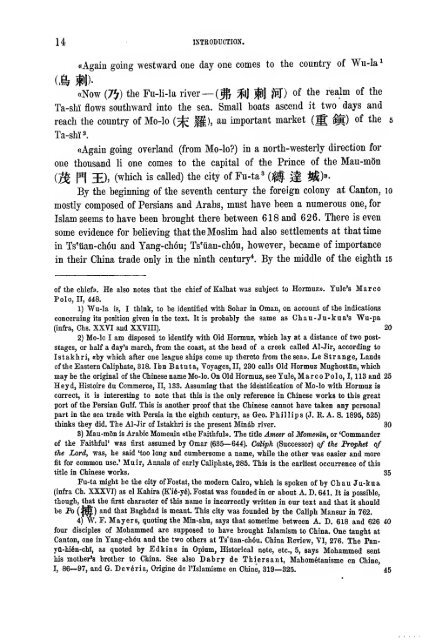Chau Ju-Kua - University of Oregon Libraries
Chau Ju-Kua - University of Oregon Libraries
Chau Ju-Kua - University of Oregon Libraries
You also want an ePaper? Increase the reach of your titles
YUMPU automatically turns print PDFs into web optimized ePapers that Google loves.
14<br />
IXTRODUCTION.<br />
aAgain going westward one day one comes to the country <strong>of</strong> Wu-la ^<br />
«Now (7^) the Fu-li-la river—(^ %\] ^j ^Rf) <strong>of</strong> the realm <strong>of</strong> the<br />
Ta-shi flows southward into the sea. Small boats ascend it two days and<br />
reach the country <strong>of</strong> Mo-lo (^ ^), an important market (g ^) <strong>of</strong> the 5<br />
Ta-shi 2.<br />
((Again going overland (from Mo-lo?) in a north-westerly direction for<br />
one thousand li one comes to the capital <strong>of</strong> the Prince <strong>of</strong> the Mau-mon<br />
(M P^ 3E)' (wliich is called) the city <strong>of</strong> Fu-ta^ (|f ^ ^)».<br />
By the beginning <strong>of</strong> the seventh century the foreign colony at Canton, 10<br />
mostly composed <strong>of</strong> Persians and Arabs, must have been a numerous one, for<br />
Islam seems to have been brought there between 618 and 626. There is even<br />
some evidence for believing that the Moslim had also settlements at that time<br />
in Ts'uan-chou and Yang-ch6u; Ts'uan-chou, however, became <strong>of</strong> importance<br />
in their China trade only in the ninth century*. By the middle <strong>of</strong> the eighth 15<br />
<strong>of</strong> the chief)). He also notes that the chief <strong>of</strong> Kalhat was subject to Hormuz». Yule's Marco<br />
Polo, II, 448.<br />
1) Wu-la is, I think, to he identified with Sohar in Oman, on account <strong>of</strong> the indications<br />
concerning its position given in the text. It is probably the same as <strong>Chau</strong>-<strong>Ju</strong>-kua's Wu-pa<br />
(infra, Chs. XXVI and XXVIII). 20<br />
2) Mo-lo I am disposed to identify with Old Hormuz, which lay at a distance <strong>of</strong> two post-<br />
stages, or half a day's march, from the coast, at the head <strong>of</strong> a creek called Al-Jir, according to<br />
Istakhri, aby which after one league ships come up thereto from the seaw. Le Strange, Lands<br />
<strong>of</strong> the Eastern Caliphate, 318. Ibn Batuta, Voyages, II, 230 calls Old Hormuz Mughostan, which<br />
maybe the original <strong>of</strong> the Chinese name Mo-lo. On Old Hormuz, see Yule, Marco Polo, 1, 113 and 25<br />
Heyd, Histoire du Commerce, II, 133. Assuming that the identification <strong>of</strong> Mo-lo with Hormuz is<br />
correct, it is interesting to note that this is the only reference in Chinese works to this great<br />
port <strong>of</strong> the Persian Gulf. This is another pro<strong>of</strong> that the Chinese cannot have taken any personal<br />
part in the sea trade with Persia in the eighth century, as Geo. Phillips (J. R. A. S. 1895, 525)<br />
thinks they did. The Al-Jir <strong>of</strong> Istakhri is the present Minab river. 30<br />
3) Mau-mon is Arabic Momenin «the Faithful)). The title Ameer al Momemn, or 'Commander<br />
<strong>of</strong> the Faithful' was first assumed by Omar (635—644). Caliph (Successor) <strong>of</strong> the Prophet <strong>of</strong><br />
the Lord, was, he said 'too long and cumbersome a name, while the other was easier and more<br />
fit for common use.' Muir, Annals <strong>of</strong> early Caliphate, 285. This is the earliest occurrence <strong>of</strong> this<br />
title in Chinese works. 35<br />
Fu-ta might be the city <strong>of</strong> Fostat, the modern Cairo, which is spoken <strong>of</strong> by <strong>Chau</strong> <strong>Ju</strong>-kua<br />
(infra Ch. XXXVI) as el Kahira (K'ifi-ye). Fostat was founded in or about A. D. 641. It is possible,<br />
though, that the first character <strong>of</strong> this name is incorrectly written in our text and that it should<br />
be Fo (;p|) and that Baghdad is meant. This city was founded by the Caliph Mansur in 762.<br />
4) W. F. Mayers, quoting the Min-shu, says that sometime between A. D. 618 and 626 40<br />
four disciples <strong>of</strong> Mohammed are supposed to have brought Islamism to China. One taught at<br />
Canton, one in Yang-chou and the two others at Ts'iian-ch6u. China Review, VI, 276. The Pan-<br />
yfl-hi6n-chi, as quoted by Edkins in Opium, Historical note, etc., 5, says Mohammed sent<br />
his mother's brother to China. See also Dabry de Thiersant, Mahom6tanisme en Chine,<br />
I, 86—97, and G. Dev6ria, Origine de I'Islamisme en Chine, 319—325. 45

















